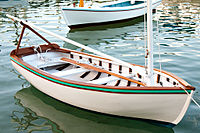Man-O-War Cay
26°35′15″N 77°00′25″W / 26.58750°N 77.00694°W
Man-O-War Cay is a small island in the Abaco region of the Bahamas.
It has a population of about 300 Bahamian residents and about 135 foreign resident families. During the summer some local houses are rented by vacationing families that have a reputation as good house guests (the exclusive nature of the locals leads noisier or more youthful vacationers to other islands). The island is famous for its boat-building history. William H. Albury was famous in the country for his tremendous boat building skills. He built his first schooner at the age of 14. Albury died in 1972, but the boat building on the Cay still lives on. The last big boat built by the William H. Albury Ship Yard and "Uncle Will", as he had come to be known, was the Esperanto. The Esperanto was later renamed The William H. Albury in his honor. The newer generations have resorted to building fiberglass boats as opposed to wooden vessels. Albury Brothers Boats builds small boats in their facility next to the water.
This island is about 2.5 miles (4.0 km) long, but relatively narrow, often less than 100 metres between the harbor and beach side of the Island. A section of island called "The Narrows" by visitors and "The Low Place" by locals is exceptionally narrow, with a beach on both sides separated by a roadway built into the rock formation between them, less than 10 metres across. The harbor side of the island faces Marsh Harbour, and a beach side runs the length of the opposite shore. The community is very close-knit, and most of the residents are in some way or another related to the Albury family. A number of workers commute each day from Marsh Harbour. There are two small grocery stores, a marina, a boat yard, a few gift shops, a hardware and lumber store, two restaurants and a bakery. Golf-carts are rented by several companies (the narrow roads, often unpaved outside of the town centre, only permit the use of golf-carts or other small vehicles). No liquor is sold on the island. The people are very conservative, and still hold deep affection and loyalty to the British Crown. The majority of the residents are avid church-goers. The island has four churches, one Non-denominational, one Pentecostal, one Methodist, and one Plymouth Brethren.
Man-O-War Cay is represented in Parliament by The MP (Member of Parliament) for the South Abaco constituency, Mr. Edison Key.
Currently, Man-O-War's representatives on the Hope Town District Council, (which also includes two other neighboring Cays) are: Mr. Jeremy Sweeting and Mr. Arthur Elden. Mr. Jeremy Sweeting serves as the Chief Councillor for their District.
Wreckage of the USS Adirondack (1862) which ran aground in August 1862 is strewn on the reef just northeast of Man-O-War. Public travel to Man-O-War Cay is via ferry from Marsh Harbour.
The diving, snorkeling and water sports around the island are truly exceptional. The people are both friendly and good-natured. The island is very safe with very little crime and is clean and well kept.

The home builders of Man O War are known throughout the Bahamas for building homes that "Are built like Ships, but bolted to the land". Indeed, all the rafters and structure are bolted together similar to ship construction and resist the hurricanes very well. The residents stand as a reminder of the independent thinking and self-reliance of the founders of the Bahamas. Several of the local boat builders still make the occasional "Abaco Dinghy" in their native woods of Madeira mahogany and other Bahamian hardwoods. They are today considered works of art and sought after by those who appreciate fine old world wooden vessels.
Further reading
- Albury, Haziel L. Man-O-War, My Island Home: A History of an Outer Abaco Island, Christian Year Publishing., 1977. ISBN 1-872734-04-9
- Rodriguez, Ruth, Out Island Portraits - Bahamas 1946-1956, Out Island Press, 1983.
